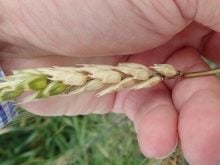Fall is the best time to control many perennial weeds with glyphosate, including foxtail barley, but it might already be too late.
Weed surveys show foxtail barley is on the increase, Manitoba Agriculture weed specialist Jeanette Gaultier said Sept. 20 on her last day in the position, during the Westman Crop Talk webinar.
“In the fall the plants are moving everything back towards the root so that they can overwinter and of course the glyphosate is going with it — it’s a very terrible pun — but you are getting to the root of the problem,” Gaultier said.
Read Also

Better data on fertilizer emissions with the Internet of Things
Web of soil sensors looks for live insights on farm greenhouse gas emissions and nitrogen fertilizer application.
Because it was dry this summer a lot of foxtail barley won’t be moving as many nutrients now to its roots. However, plants with green leaves will absorb the herbicide.
The recommended rate to control foxtail barley with glyphosate is one to two litres per acre of Roundup equivalent, but Gaultier said she usually recommends two litres.
“I just find that foxtail barley can be so difficult (to control), why take a chance?” she said.
Foxtail barley can be controlled (90 per cent of plants killed) or suppressed (60 to 80 per cent of plants killed) in the spring, depending on plant maturity, Gaultier said.
New plants are easier to kill than established ones.
“In spring I never recommend anything lower than the two-litre equivalent (Roundup),” she said.
Early application is usually better when controlling weeds. However, Gaultier said research at the University of Saskatchewan shows spraying a little later in the spring can be more effective.
“The reason is foxtail barley has such skinny leaves when it’s very small…” she said.
There’s a sweet spot when the leaves are larger, but before the plant gets too mature.
There are some in-crop control options when growing broad-leaved crops, using non-selective Group 1 grassy weed killers. They include herbicides that contain quizalofop such as Assure II, which offers control and Contender or Yuma, which offer suppression, Gaultier said.
Poast Ultra, with the active ingredient sethoxydim, works too.
New research from the University of Alberta shows some pre-emergence products suppress foxtail barley. One is Focus — a combination of cafentrazone (Group 14) and pyroxasulfone (Group 15).
The university also found layering Focus with glyphosate, or a Group 1, can work, but only ahead of spring wheat, winter wheat, soybeans and corn.
“The other big thing is it requires activation by rain,” Gaultier said.
It might not have worked this year because it was dry, she said.
Foxtail barley is often a problem on saline land so reducing salinity is another way to control the weed, she said.
Foxtail barley grows best under the same conditions that favour crops. It often stands out when conditions are dry because there’s less crop competition.
“I definitely think it has taken advantage of that this year,” Gaultier said.
Tillage is the best way to control foxtail barley, she added.
“It doesn’t have to be deep,” she said. “Unlike a lot of perennials, foxtail barley does actually have a very shallow, fibrous root system.”
Burying foxtail barley seed three inches can reduce its seed bank in two to three years.
But tillage isn’t always an option, especially in minimum- and zero-till systems.
The same is true of pastures. Kerb, an older herbicide, is an option, but since it breaks down quickly in the soil it must be applied late in the fall, just before freeze-up, Gaultier said.
It also needs moisture to activate it, which usually comes with snowmelt and spring rains.
However, Kerb can injure some grasses, she added.
Regar brome, timothy, bluegrass, red fescue and crested wheatgrass have poor Kerb tolerance.
Wheatgrass, meadow foxtail, buffalograss, green needlegrass, tall fescue, smooth brome, creeping and red fescue have intermediate tolerance.
Tall wheatgrass, western wheatgrass, slender wheatgrass, red top, creeping foxtail, orchardgrass, altai wildrye, Russian wildrye, meadow fescue, alkali sacaton have high tolerance.















